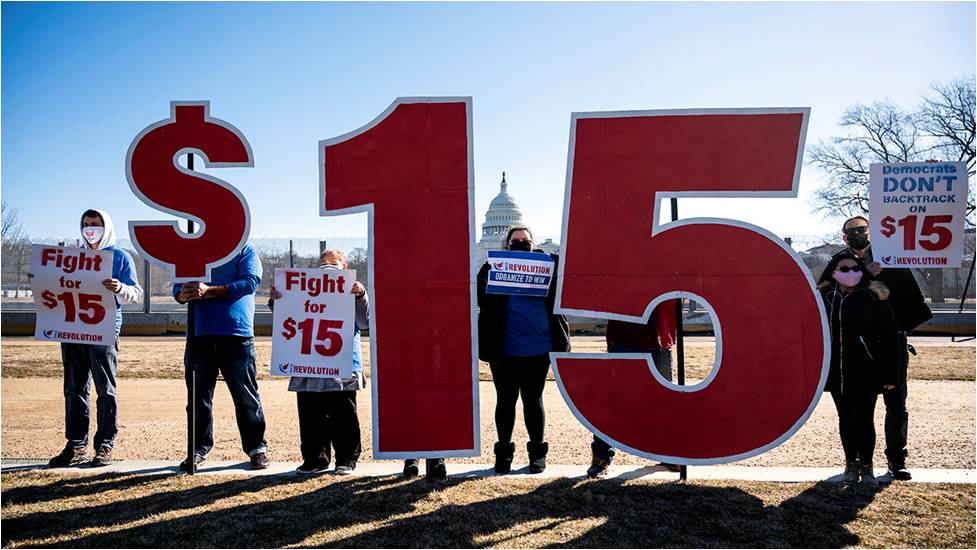
With the 2020 election cycle drawing to a close, a newly-assembled body of lawmakers in Washington is faced with the task of deciding the future of the federal minimum wage in America, which has been set at 7.25 USD per hour ever since 2009. From what we know, this taskwill inevitably lead to unending political drama and partisan polarisation. Even as congressmen and women in Capitol Hill attempt to find a plausible middle ground on the federal level, this debate will continueplaying out throughout the United States inboth state legislatures and city councils. Despite its apparent flaws and harms, the minimum wage continues to receive major support from left-wing politicians, unions, and a majority of Americans, who see its adoption as the key to achieving social justice in America.Therefore, after prolonged research,I’ve dedicated this essay towards making the case against the implementation of a minimum wage and in favour of a free market alternative.
Minimum wage is a term used to describe the lowest wage that a company orbusiness could legally pay its employees in a certain country. Most countries around the world have already enacted minimum wage laws, including many developedcountries like the US, most EU countries, and Japan. To understand the divisive nature of minimum wage in American politics, we’ll have to return back in time to 1938, when President Franklin D. Roosevelt signed the Fair Labour Standards Act into law. Before it was passed, people, including children,worked extremely long hours only to get paid pennies at the end of the day(Amadeo, 2021). This was largely because of the “Great Depression”, which started out as a stock market crash in 1929 that quickly turned into an economic quagmire, dragging 45 percent of Americans below the poverty line(Dickerns & Morales, 2004). Among the measures included was the implementation of the first national minimum wage in US history, making it illegal to pay workers any less than 0.25 USD (4.73 USD in today’s money) per hour(Amadeo, 2021).
The passage of this law would set off a decades-long battle between fiscal conservatives and liberals that continuesup to this date. 2009 was the latest episode in this battle, leaving American workers with a minimum wage of 7.25 USD per hour, which is largely seen as a compromise devised to appease both republicans and democrats. On a state level, minimum wage policies remain highly mixed. As of 2021, 20 states have minimum wages that are either under or equal to the federal minimum of 2009, while the other 30 states, the District of Colombia, and scores of cities have decided to raise their minimum wages(DOL, 2021). In the 2020 presidential elections, many in the democratic party endorsed the idea of raising the federal minimum wage to 15 USD per hour, including then-candidate Joe Biden.
This trend is representative of a growing consensus within left-wing and progressive circles surrounding the role of the government in the economy: the more involved it gets, the better it is for workers.With the minimum wage, among many other things, this line of thinking is faulty and has produced a whole host of negative consequences, especially for the very people thatthis law is supposed to help. The following segment will help explain why.
My entire argument – in fact, my entire economic philosophy – is predicated upon one quote by the famed American economist Thomas Sowell: There are no solutions.There are only trade-offs(Warburg, 2018).This quote captures an unfortunate reality about most government programmes: while they might provide us with short-term solutions, there are always going to be trade-offs. In the case of a minimum wage hike, these trade-offs are too grave to even consider. According to the Congressional Budget Office(Smith, 2021), an estimated 1.4 million jobs will be lost by the time the federal minimum wage reaches 15 USD per hour in 2025. It is also reported that the federal deficit would increase by 54 billion USD due to the increased use of government programmes such as Medicaid. This would be in exchange for 0.9 million people being lifted out of poverty. While a number of economists contest these figures, it is safe to say that the majority of academic literature in this area indicate an overall negative impact(Bourne, 2021).
Furthermore, a minimum wage – let alone a minimum wage hike – would disproportionately impact small, service-basedbusinesses like restaurants and salonsthattend to rely heavily on human labour. In2015, the American Enterprise Institute(Perry, 2015) pointed to an increase in restaurant closures in the Seattle area with the approach of the implementation date of the new 15 USD per hour minimum wage. This new law demands that employers gradually raise their wages to the 15 USD threshold by 2022.While the Seattle City Council was the first to celebrate this move as “an action to address income inequality,”so manyrestauranteurs and business owners were faced with the prospect of either reducing the working hours of their employees or laying them off altogether. Faced with thin profit margins, businesses could also opt to raise their prices.
This brings us to another phenomenon, which is dubbed “wage-push inflation”.This type of inflation basically occurs when business owners have to raise their prices to substitute for lost funds. In this case, to substitute for increased labour costs. According to Harasztosi and Lindner, the doubling of Hungary’s minimum wage led to a 7 percent to 14 percent increase in prices over a 4-year period(Wilson, 2020). While wealthier people could afford such increases, working-class or even middle-class households might find it difficult to adjust to such prices. In this case, a company could either lower its prices or risk running out of business. Many resort to outsourcing jobs in order to maintain competitive prices, pushing the manufacturing industry to nations where labour is cheaper. Today, job outsourcing remains such a politically contentious topic, especially with the resurgence of populism in both the left and right [1].
In the midst of all of this, the biggest losers are the very people that this law is supposed to help: low-skilled workers. Whether in the manufacturing or service industry, low-skilled workers might be guaranteed more per hour and might actually gain more under this law– that’s if they manage to keep their jobs and hours intact. They also have to worry about automation, especially in big businesses such as Amazon, Target, and Walmart. By far, this phenomenon poses the most serious riskto workers, especially when the price of employing them seemshigher than that of automation or outsourcing; this wouldleave huge portions of the low-skilled workforce vulnerable to job insecurity. Such laws also make it harder for teenagers – who tend to be less experienced than their adult counterparts – to enter the workforce, with a 2006 University of Georgia study finding that “every 10 percent increase in the minimum wage was associated with a 4.6 to 9.0 percent decline in teenage employment”(Minimum Wage: Teen Unemployment 2013). Also, a 2017 London School of Economics paper reveals that the negative effects of raising the minimum wage are felt the most by those working in the manufacturing industry, and those that are young, old, female, and black (Clifford, 2017).
As frustrating as these findingsmight be, there is no reason to give up on our search for fair wages. My search for answers brought me to a better, less harmful solution: allowing the free market to lead the way. Instead of burdening the private sector with unending laws and regulations, the government needs to take a step back. Capitalism is a systembased on voluntary transactions between the parties involved and an intricate mechanism of supply and demand. In this system, employers and employees (both of whom rely on one another) are allowedto negotiate the most suitable wages, which often allows them to reacha compromise.An employer has to provide his employees with livable wages and attractive work benefits, lest he lose them to other businesses. Similarly, an employee has to perform his work diligently, otherwise he’d getreplaced with another person. This way, the invisible hand, as Adam Smith described it, will guide both parties towards a middle ground, ideally satisfying the needs and demands of both employers and employees.
There are many living examples of this at workbut none are quite aspromising asSweden’s: even though this Nordic countrydoesn’t have an official minimum wage, its living standards remain very high, with some charts ranking it as one of the happiest countries on earth. According to the Nomad Capitalist(Nomad Research Team, 2019), this is because Sweden maintains a robust and competitive free market system, where employees and private-sector unions are allowed to negotiate fair wages – often through collective bargaining– without much need for government intervention.
In conclusion, while minimum wage sounds like a noble way for governments to help workers, it remains highly ineffective at best and harmful at worst. Instead of improving the lives of low-skilled workers, it makes them more vulnerable to job insecurity, since it prompts companies and businesses to consider automation and outsourcing as viable and cheaper alternatives. A minimum wage also makes it harder for teenagers, elders, and people of colourto enter the workforce. Conversely, a free market/unionised labour duo, despite its flaws and imperfections, provides us with a more effectivealternativethat improves thelives and wages of workerswithout the abovementioned trade-offs.
Bibliography:
Amadeo, K. (2021, March 29). 6 Pros and 6 Cons of Raising the Minimum Wage. The Balance. https://www.thebalance.com/us-minimum-wage-what-it-is-history-and-who-must-comply-3306209.
Bourne, R. (2021, February 25). The Case against a $15 Federal Minimum Wage: Q&A. Cato Institute. https://www.cato.org/commentary/case-against-15-federal-minimum-wage-qa.
Clifford, C. (2017, August 17). Here’s new evidence minimum-wage hikes result in workers being replaced by robotsCather. CNBC. https://www.cnbc.com/2017/08/16/evidence-minimum-wage-hikes-result-in-workers-being-replaced-by-robots.html.
Dickerns, D., & Morales, C. (2004). Poverty. Center for Democratic Culture. https://cdclv.unlv.edu/healthnv/poverty.html.
DOL. (2021, May 1). Consolidated Minimum Wage Table. U.S. Department of Labor . https://www.dol.gov/agencies/whd/mw-consolidated.
Minimum Wage: Teen Unemployment. Employment Policies Institute. (2013, March 7). https://epionline.org/minimum-wage/minimum-wage-teen-unemployment/#:~:text=Various%20studies%20have%20found%20that,percent%20decline%20in%20teenage%20employment.
Nomad Research Team (Ed.). (2019, December 24). Six Countries with No Minimum Wage. Nomad Capitalist. https://nomadcapitalist.com/2019/03/24/countries-no-minimum-wage/.
Perry, M. J. (2015, March 14). Seattle’s new minimum wage law takes effect April 1 but is already leading to restaurant closings and job losses. American Enterprise Institute. https://www.aei.org/carpe-diem/seattles-new-minimum-wage-law-takes-effect-april-1-but-is-already-leading-to-restaurant-closings-and-job-losses/.
Smith, K. A. (2021, May 12). What You Need To Know About The Minimum Wage Debate. Forbes. https://www.forbes.com/advisor/personal-finance/minimum-wage-debate/.
Warburg, M. (2018, July 19). There Are No Solutions, Only Trade-Offs – The Ideology Blight. News24. https://www.news24.com/news24/xArchive/Voices/there-are-no-solutions-only-trade-offs-the-ideology-blight-20180719.
Wilson, C. (2020, September 30). Estimating the Impact Of Minimum Wage on Prices. Frontier Economics: Low Pay Commission. https://assets.publishing.service.gov.uk/government/uploads/system/uploads/attachment_data/file/942445/Frontier_Economics_-_Estimating_the_impact_of_minimum_wages_on_prices_-_FINAL.PDF.
[1] Despite deep-seated political differences, Donald Trump (a right-wing populist) and Bernie Sanders (a left-wing populist) have both advocated for reviving America’s manufacturing industry; hence, their opposition towards globalism and outsourcing.
Author Bio: My name is Ali Mukhtar, and I’m a high school student from Bahrain. I enjoy writing, reading, and drawing. I also conduct interviews from my Book Review Podcast, which is a platform in Instagram.


